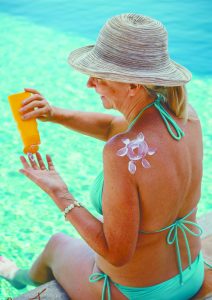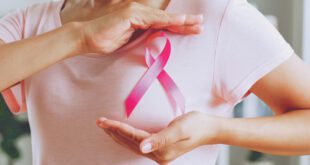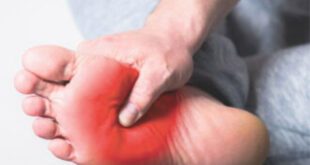Written by Patricia Spitzer, PA-C – In collaboration with Dr. Thi Tran
 Spring is in the air and that means spring break and warmer temperatures are right around the corner. It’s a good time to go over sunscreens and sun prevention. According to the American Academy of Dermatology, 1 in 5 Americans will develop skin cancer in their lifetime. When you step into the aisle with numerous types of sunscreens is it overwhelming? Do you know what to look for when choosing? If you don’t, you’re certainly not alone. In fact, most patients don’t know the difference between the types of ultraviolent radiation or how to choose which sunscreen is the best or what measures to take to protect their skin.
Spring is in the air and that means spring break and warmer temperatures are right around the corner. It’s a good time to go over sunscreens and sun prevention. According to the American Academy of Dermatology, 1 in 5 Americans will develop skin cancer in their lifetime. When you step into the aisle with numerous types of sunscreens is it overwhelming? Do you know what to look for when choosing? If you don’t, you’re certainly not alone. In fact, most patients don’t know the difference between the types of ultraviolent radiation or how to choose which sunscreen is the best or what measures to take to protect their skin.
We use the abbreviation SPF but a lot of folks don’t know what it stands for and definitely not what it means. SPF stands for sun protection factor. The sun protection factor measures the length of time a product protects against skin reddening (minimum erythema dose) due to UVB radiation compared to how long skin takes to redden without protection. For example, if it takes 20 minutes to begin reddening without protection then using an SPF 15 sunscreen would prevent reddening 15 times longer, approximately 5 hours. This is an average and doesn’t address the UVA wavelength, so please keep this in mind. When it comes to UV radiation penetration, we measure these in photons, if someone is not wearing protection 100 photons will reach the skin, however if an individual is wearing SPF 15 only 7 photons reach (93% coverage), if SPF 30 only 3 photons reach the skin (97%). However, as you increase the number to SPF 50 you will notice it changes to 98% which isn’t much of a change and thus the higher SPF’s can be confusing as their coverage is not much different. None of the sunscreens cover 100 percent. However, higher SPF’s may be recommended in some individuals based on their overall skin cancer risk and compliance level to cover for application error.
Please keep in mind these numbers are based on standard measurements of protection against UVB rays as there are no standard measurements for UVA rays. Broad spectrum refers to the blockage of both UVA and UVB rays but not to the exact extent of the UVA. Some ways to tell if the product protects against the UVA wavelength spectrum check to see if it contains the following chemicals avobenzone, zinc oxide or titanium dioxide as these theoretically cover the spectrum.
All this talk about ultraviolet radiation, UVA vs. UVB have you confused yet? Let me explain the difference between the two.
• UVA are your long-wave rays (320-400 nanometers) and these penetrate deeper into the dermis of the skin and thus are considered the primary player in production of photoaging changes such as wrinkling, pigmentation changes and loss of collagen leading to thinning of the skin. Even though UVA rays are not as likely to cause sunburns there is evidence to suggest it promotes the carcinogenic effects of UVB rays.
• UVB are your short wave rays (290-320 nanometers) that are mainly responsible for sunburns. Sunscreen measurement standards are based on their efficacy against UVB penetration. Basal cell carcinoma, as well as squamous cell carcinoma and some melanomas are due to UVB radiation damage.
Sunscreen isn’t the only way to protect against sunburn.. There are some general recommendations by most dermatologists as well as the Skin Cancer Foundation to follow when choosing and using a sunscreen/sunblock as well as some recommendation for protecting the skin in general:
• Anyone over the age of 6 months should apply sunscreen daily. Babies under the age of 6 months should not be exposed to the sun and their skin can be sensitive to the chemicals in sunscreens so it’s best to use other measures such as avoidance or sun protective clothing, hats, etc.
• When choosing a sunscreen or sunblock look for one that is broad spectrum (protects against both UVA/UVB rays)
– Please remember the standard measurements are for protection against UVB rays specifically but look for the chemicals avobenzone, zinc oxide and titanium dioxide for blockage of the UVA spectrum
• Moisturizers containing SPF 15-30 are okay for everyday use with only brief periods of exposure to the sun
• Water resistant (40 minutes) or very water resistant (80 minutes) are good for beach days or those who play sports and will be sweating but please remember to reapply every 2 hours
• Apply 30 minutes before sun exposure
• When applying sunscreen please remember use 1 oz. (2 tablespoons) to cover exposed areas of the body
• Re-apply every 2 hours
• It is a myth that you cannot get a sunburn during cloudy weather, please wear sunscreen even during these days
• Overall, please seek shade during the hours of 10AM-2PM as these are the times with the most intense UV rays.
• Avoid tanning booths
• Use cover up clothing including sunglasses, hats and sun protective clothing
Please remember to check your skin monthly for new lesions and see your skin care provider regularly.
Village Dermotlogy
352-751-6565 | www.villagederm.com
1950 Laurel Manor Drive
Building 220—Suite #224, The Villages, FL 32162
Check Also
Revolutionizing Neuropathy Treatment: The Summus Laser Approach at LaserLab
Neuropathy, a condition affecting an estimated 42.5 million Americans, can significantly impact one’s quality of …
 Central Florida Health and Wellness Magazine Health and Wellness Articles of the Villages
Central Florida Health and Wellness Magazine Health and Wellness Articles of the Villages



